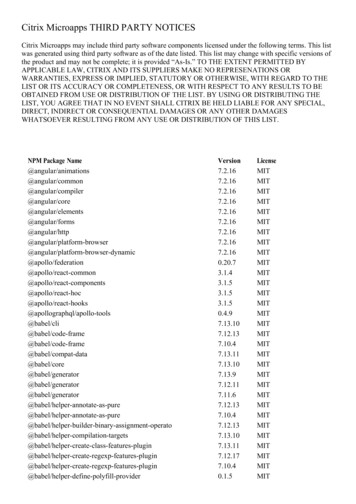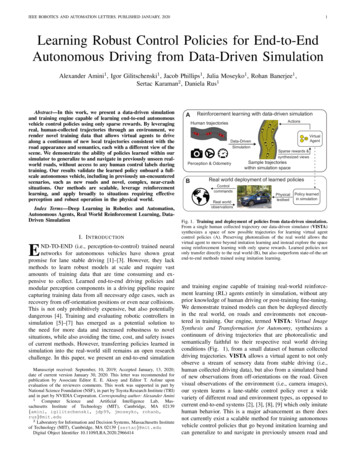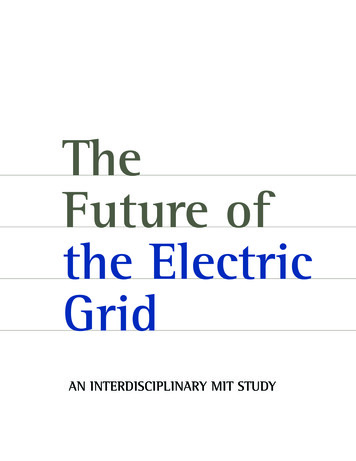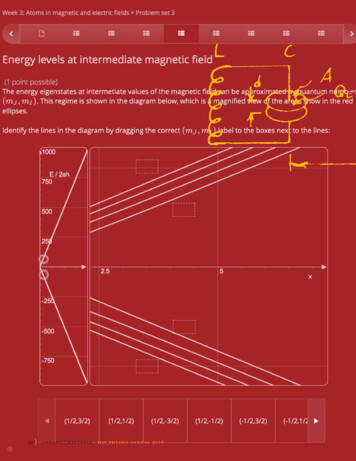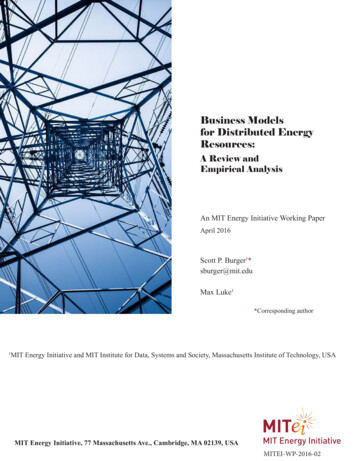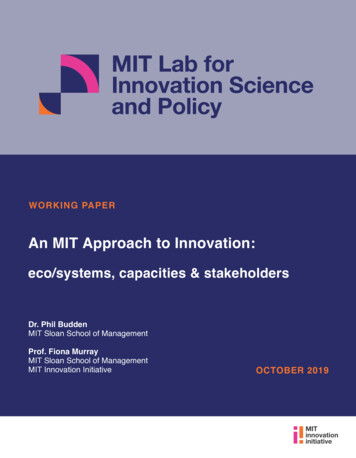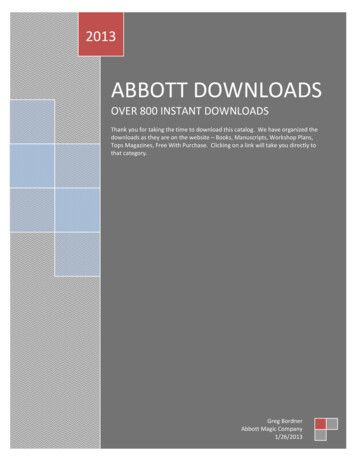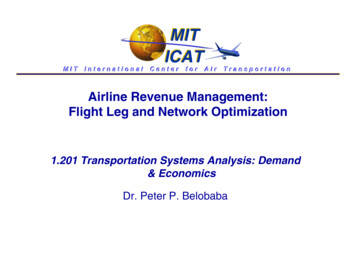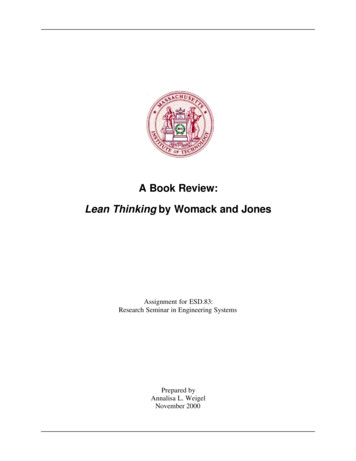
Transcription
A Book Review:Lean Thinking by Womack and JonesAssignment for ESD.83:Research Seminar in Engineering SystemsPrepared byAnnalisa L. WeigelNovember 2000
Annalisa L. WeigelBook Review“We can lick gravity, but sometimes the paperwork is overwhelming.”– Werner von BraunSummary of Lean ThinkingLean Thinking: Banish Waste and Create Wealth in Your Corporation by James P. Womack andDaniel T. Jones was published in 1996 by Simon & Schuster, New York. This book follows aprevious highly successful book by Womack, Jones and Roos entitled The Machine ThatChanged the World. Both books address the revolution in manufacturing represented by theToyota Production System of the Toyota Corporation of Japan. This type of manufacturingsystem is called a “lean system” and is contrasted throughout the book with the traditional “massproduction” system of manufacturing epitomized by batch-and-queue methods.The authors argue that a lean way of thinking allows companies to “specify value, line up valuecreating actions in the best sequence, conduct these activities without interruption wheneversomeone requests them, and perform them more and more effectively. 1 ” This statement leads tothe five principles of lean thinking: Value, Value Stream, Flow, Pull and Perfection.Value is defined by the authors as a “capability provided to customer at the right time at anappropriate price, as defined in each case by the customer. 2 ” Value is the critical starting pointfor lean thinking, and can only be defined by the ultimate end customer. The ultimate endcustomer, or the user of the product, is contrasted with interim customers, such sales, marketing,distribution, suppliers, etc. Value also is product-specific, and the authors argue it is onlymeaningful when expressed in terms of a specific product.The value stream is defined in Lean Thinking as the set of all the “specific activities required todesign, order, and provide a specific product, from concept to launch, order to delivery, and rawmaterials into the hands of the customer. 3 ” To create a value stream, describe what happens to aproduct at each step in its production, from design to order to raw material to delivery. There arethree types of activities in the value stream – one kind adds value, and the other two are “muda”(the Japanese word for waste) 4 : 1234Value-Added: Those activties that unambiguously create value.Type One Muda: Activities that create no value but seem to be unavoidable withcurrent technologies or production assets.Type Two Muda: Activities that create no value and are immediately avoidable.Womack & Jones. Lean Thinking. New York: Simon & Schuster, 1996. p. 15.Womack & Jones, p. 311.Womack & Jones, p. 311.All three definitions from Womack & Jones, p. 20.ESD.83, Fall 2000Page 2
Annalisa L. WeigelBook ReviewSome examples of muda are mistakes which require rectification, groups of people in adownstream activity waiting on an upstream activity, or goods which don’t meet the needs of thecustomer.The lean principle of flow is defined as the “progressive achievement of tasks along the valuestream so that a product proceeds from design to launch, order to delivery and raw materials intothe hands of the customer with no stoppages, scrap or backflows. 5 ” This translates as a directiveto abandon the traditional batch-and-queue mode of thinking that seems commonsense to most.Ways to foster flow include enabling quick changes of tools in manufacturing, as well as rightsizing machines and locating sequential steps adjacent to one another.The fourth lean principle of pull is defined by the authors as a “system of cascading productionand delivery instructions from downstream to upstream in which nothing is produced by theupstream supplier until the downstream customer signals a need. 6 ” This is in contrast withpushing products through a system, which is unresponsive to the customer and results inunnecessary inventory buildup.The fifth and final lean principle is perfection, defined again by the authors as the “completeelimination of muda so that all activities along a value stream create value. 7 ” This fifth principlemakes the pursuit of lean a never-ending process, as there will always be activities that areconsidered muda in the value stream and the complete elimination of muda is more of a desiredend-state that a truly achievable goal.After describing their concept of the five lean principles in the Part I of Lean Thinking, theauthors then present five case studies in Part II of applying lean thinking concepts to companiesthat were in trouble. The case studies cover a pallet stretch-wrapping company, the WiremoldCompany, Pratt & Whitney jet engines, the specialty automobile manufacturer Porsche, and aJapanese radiator and boiler manufacturing company. Each of the case studies meets withdifferent types and level of success in implementing a lean system and deriving benefits from it.The authors then conclude their book with an outline for an “action plan” a company could useto begin their lean transformation (a summary chart is given on page 270), a brief discussion ofintegrating multiple firms into a trust-based lean enterprise, and a quick look at applying lean totraditional non-manufacturing sectors of the economy.Putting Lean Thinking in the Context of the Manufacturing DisciplineLean Thinking represents one of the newer schools of thought in manufacturing. Earlymanufacturing began as craft production, where a single person made an entire single product.With the advent of industrial production technology, mass manufacturing came into being. Leanis in direct contrast with the mass system of production that stressed economies of scale that567Womack & Jones, p. 306.Womack & Jones, p. 309.Womack & Jones, p. 308.ESD.83, Fall 2000Page 3
Annalisa L. WeigelBook Reviewcame from making large quantities of items in a batch-and-queue mode. The mass productionway of thinking can be illustrated by looking at automotive painting factories. These factorieswould typically have large paint color change-over times, which resulted in painting white carsone week, blue cars the next week, black cars in another week, and so on. This meant that therewould be only one time every month or two when a customer could obtain the specific color theyneeded. Recently, some factories have upgraded and right-sized their painting equipment so thatcolor change-over times are very fast, enabling rapid response to the customer. This rapidresponse to the customer, and the customer’s ability to pull the product, are very representativeof a lean system.Other manufacturing management concepts that have received attention over the past fewdecades are not incongruent with lean principles, and many fit nicely in the framework of leanthinking and complement it. ‘Six sigma’ methods are a way to bring production processes undercontrol to result in a reduction in defect rate. This offers a way to eliminate muda (waste) in thevalue stream and make the value stream flow. Continuous improvement (CI) describes how anorganization is constantly evaluating itself and learning from its mistakes, much in the way thelean concept of perfection encourages continuous reexamination of the value stream for ways toeliminate waste. Total quality management (TQM) and quality circles are techniques to involveemployees in management decisions and problem solving. Employees are typically the onesclosest to the manufacturing process and have valuable insights into ways to eliminate waste intheir groups. Thus, as ways to reduce waste, TQM and quality circles help foster the lean goal offlow in the value stream.To conclude on the context of lean in the manufacturing discipline and what distinguishes it frompast thrusts, Womack and Jones offer their own opinion on how their lean principles are differentfrom previous cuts on the subject of manufacturing management.“We are putting the entire value stream for specific products relentlessly in theforeground and rethinking every aspect of jobs, careers, functions, and firms in order tocorrectly specify value and make it flow continuously along the whole length of thestream as pulled by the customer in pursuit of perfection. 8 ”Success of Lean ThinkingTo take a first cut on success and examine the Amazon.com sales rank of Lean Thinking, it isfound to be 9,708 out of over hundreds of thousands of books. This puts it comfortably in thetop few percent of titles sold by the online warehouse over the course of its existence, albeitbrief.But more critically, if the success of Lean Thinking is defined as how much attention majorAmerican manufacturing companies are paying to lean principles, then it can be consideredmostly successful as many companies in different markets are trying to adopt lean methods. In8Womack & Jones, p. 275.ESD.83, Fall 2000Page 4
Annalisa L. WeigelBook Reviewaddition, people are trying to apply lean principles outside the strict manufacturing domain inwhich Womack and Jones examined it. For example, Cusumano and Nobeoka in their bookThinking Beyond Lean look at applying lean principles to product development processes.However, Womack and Jones have left many of the details of overcoming institutional barriersto lean out of their discussion. Certainly the five major cases presented in their work deal withthese issues somewhat, but critics say these are clear-cut cases and thus not representative ofwhat exists for most other companies. Many practitioners would like to see more work in thefollowing areas:9 Creating senior leadership commitment to a lean transformation Overcoming policy and legal constraints to implementing lean principles Effectively dealing with culture and social systems in implementing lean Reinventing business systems (eg. accounting, resource planning) to work in harmonywith lean concepts Determining appropriate performance incentives and metrics in a lean environmentBut perhaps this omission was intentional, as Womack runs a consulting organization whose goalis to help companies implement lean practices. If the book gave away all the secrets, therewould be no money to be made in consulting.9Cutcher-Gershenfeld, Joel. “Barriers to Lean,” Presentation to Plenary Conference, Lean Aerospace Initiative.1999.ESD.83, Fall 2000Page 5
Summary of Lean Thinking Lean Thinking: Banish Waste and Create Wealth in Your Corporation by James P. Womack and Daniel T. Jones was published in 1996 by Simon & Schuster, New York. This book follows a previous highly successful book by Womack, Jones and Roos entitled The Machine That Ch
